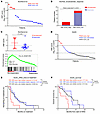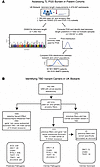Issue published August 15, 2025 Previous issue

- Volume 135, Issue 16
Go to section:
On the cover: SOX2 regulates upper GI squamous epithelial identity
Jin et al. report the critical role of the transcription factor SOX2 in foregut squamous epithelial differentiation. Decreased expression of SOX2 is an initiating step in progression to Barrett’s esophagus. The cover art was produced using Adobe Photoshop based on an H&E image of Barrett’s esophagus adjacent to esophageal squamous epithelium. Image credit: Ramon Jin.
In-Press Preview - More
Abstract
The incretin receptor agonists semaglutide and tirzepatide have transformed the medical management of obesity. The neural mechanisms by which incretin analogs regulate appetite remain incompletely understood, and dissecting this process is critical for the development of next-generation anti-obesity drugs that are more targeted and tolerable. Moreover, the physiologic functions of incretins in appetite regulation and gut-brain communication have remained elusive. Using in vivo fiber photometry, we discovered distinct pharmacologic and physiologic roles for the incretin hormones glucose-dependent insulinotropic peptide (GIP) and glucagon-like peptide-1 (GLP-1). We showed that GIP, but not GLP-1, was required for normal nutrient-mediated inhibition of hunger-promoting AgRP neurons. By contrast, both GIP and GLP-1 analogs at pharmacologic doses were sufficient to inhibit AgRP neurons. The magnitude of neural inhibition was proportional to the effect of each incretin on food intake, and dual GIP and GLP-1 receptor agonism more potently inhibited AgRP neurons and suppressed food intake than either agonist alone. Our results have revealed a role for endogenous GIP in gut-brain appetite regulation and indicate that incretin analogs act in part via AgRP neurons to mediate their anorectic effects.
Authors
Hayley E. McMorrow, Andrew B. Cohen, Carolyn M. Lorch, Nikolas W. Hayes, Stefan W. Fleps, Joshua A. Frydman, Jessica L. Xia, Ricardo J. Samms, Lisa R. Beutler
Abstract
Authors
Masahiko Shigemura, Felix L. Nunez-Santana, S.Marina Casalino-Matsuda, David Kirchenbuechler, Radmila Nafikova, Fei Chen, Zhan Yu, Yuliana V. Sokolenko, Estefani Diaz, Suchitra Swaminathan, Suror Mohsin, Rizaldy P. Scott, Lynn C. Welch, Chitaru Kurihara, Emilia Lecuona, G.R. Scott Budinger, Peter H. S. Sporn, Jacob I. Sznajder, Ankit Bharat
Abstract
Protein phosphatase 2A (PP2A) is a serine/threonine phosphatase in the brain. Mutations in PPP2R1A, encoding the scaffolding subunit, are linked to intellectual disability, although the underlying mechanisms remain unclear. This study examined mice with heterozygous deletion of Ppp2r1a in forebrain excitatory neurons (NEX-het-conditional knockout, NEX-het-cKO). These mice exhibited impaired spatial learning and memory, resembling Ppp2r1a-associated intellectual disability. Ppp2r1a haploinsufficiency also led to increased excitatory synaptic strength and reduced inhibitory synapse numbers on pyramidal neurons. The increased excitatory synaptic transmission was attributed to increased presynaptic release probability (Pr), likely due to reduced levels of 2-arachidonoyl glycerol (2-AG). This reduction in 2-AG was associated with increased transcription of monoacylglycerol lipase (MAGL), driven by destabilization of enhancer of zeste homolog 2 (EZH2) in NEX-het-cKO mice. Importantly, the MAGL inhibitor JZL184 effectively restored both synaptic and learning deficits. Our findings uncover an unexpected role of PPP2R1A in regulating endocannabinoid signaling, providing fresh molecular and synaptic insights into the mechanisms underlying intellectual disability.
Authors
Yirong Wang, Weicheng Duan, Hua Li, Zhiwei Tang, Ruyi Cai, Shangxuan Cai, Guanghao Deng, Liangpei Chen, Hongyan Luo, Liping Chen, Yulong Li, Jian-Zhi Wang, Bo Xiong, Man Jiang
Abstract
Inflammatory diseases contribute to secondary osteoporosis. Hypertension is a highly prevalent inflammatory condition that is clinically associated with reduced bone mineral density and increased risk for fragility fracture. In this study, we showed that a significant loss in bone mass and strength occurs in two pre-clinical models of hypertension. This accompanied increases in immune cell populations, including monocytes, macrophages, and IL-17A-producing T cell subtypes in the bone marrow of hypertensive mice. Neutralizing IL-17A in angiotensin (ang) II-infused mice blunted hypertension-induced loss of bone mass and strength due to decreased osteoclastogenesis. Likewise, the inhibition of the CSF-1 receptor blunted loss of bone mass and prevented loss of bone strength in hypertensive mice. In an analysis of UK Biobank data, circulating bone remodeling markers exhibited striking associations with blood pressure and bone mineral density in > 27,000 humans. These findings illustrate a potential mechanism by which hypertension activates immune cells in the bone marrow, encouraging osteoclastogenesis and eventual loss in bone mass and strength.
Authors
Elizabeth M. Hennen, Sasidhar Uppuganti, Néstor de la Visitación, Wei Chen, Jaya Krishnan, Lawrence A. Vecchi III, David M. Patrick, Mateusz Siedlinski, Matteo Lemoli, Rachel Delgado, Mark P. de Caestecker, Wenhan Chang, Tomasz J. Guzik, Rachelle W. Johnson, David G. Harrison, Jeffry S. Nyman
Abstract
Cancer cells present neoantigens dominantly through MHC class I (MHCI) to drive tumor rejection through cytotoxic CD8+ T-cells. There is growing recognition that a subset of tumors express MHC class II (MHCII), causing recognition of antigens by TCRs of CD4+ T-cells that contribute to the anti-tumor response. We find that mouse BrafV600E-driven anaplastic thyroid cancers (ATC) respond markedly to the RAF + MEK inhibitors dabrafenib and trametinib (dab/tram) and that this is associated with upregulation of MhcII in cancer cells and increased CD4+ T-cell infiltration. A subset of recurrent tumors lose MhcII expression due to silencing of Ciita, the master transcriptional regulator of MhcII, despite preserved interferon gamma signal transduction, which can be rescued by EZH2 inhibition. Orthotopically-implanted Ciita–/– and H2-Ab1–/– ATC cells into immune competent mice become unresponsive to the MAPK inhibitors. Moreover, depletion of CD4+, but not CD8+ T-cells, also abrogates response to dab/tram. These findings implicate MHCII-driven CD4+ T cell activation as a key determinant of the response of Braf-mutant ATCs to MAPK inhibition.
Authors
Vera Tiedje, Jillian Greenberg, Tianyue Qin, Soo-Yeon Im, Gnana P. Krishnamoorthy, Laura Boucai, Bin Xu, Jena D. French, Eric J. Sherman, Alan L. Ho, Elisa de Stanchina, Nicholas D. Socci, Jian Jin, Ronald A. Ghossein, Jeffrey A. Knauf, Richard P. Koche, James A. Fagin
View more articles by topic:
Sign up for email alerts
Review Series - More
Series edited by Ben Z. Stanger
Pancreatic Cancer
Series edited by Ben Z. Stanger
Pancreatic ductal adenocarcinoma (PDAC) has among the poorest prognosis and highest refractory rates of all tumor types. The reviews in this series, by Dr. Ben Z. Stanger, bring together experts across multiple disciplines to explore what makes PDAC and other pancreatic cancers so distinctively challenging and provide an update on recent multipronged approaches aimed at improving early diagnosis and treatment.
×






























